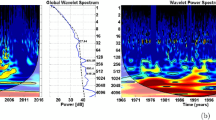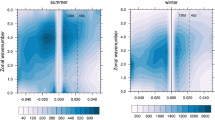Abstract
The first six Chebyshev polynomial coefficients (i.e.,A 08 ,A 01 ,A 10 ,A 11 ,A 02 , A20) were derived from monthly mean geopotential height over East Asia for the period 1951–1983. Spectral analysis of these coefficients reveals relative maxima of power in the frequency bands of 200 months (≈ 16.7 years), 25 months (the quasi-biennial oscillation), 5–6 months, and 2–3 months. Cross-spectral characteristics between Chebyshev coefficients and the Southern Oscillation Index (SOI) were also explored. Coherence spectrum for the zonal and meridional circulation index (A 01 andA 10 ) with the SOI was significant near 4 years, the QBO, and 2–3 months. Some physical explanations were offered for the spatial linkages (i.e., teleconnections) between the SO and atmospheric circulation anomalies over East Asia.
Similar content being viewed by others
References
Chen Wanlong et al. (1989), Relationship between long-term characteristic variation in East Asia summer circulation index and rainfall over Northwest China, Symposium on the 50th anniversary of Professor Yao Zhensheng engaged in education and research in the meteorological field (in press). Meteorology Press, Beijing.
Chen Yuqiong and Wang Chaifang (1980), A preliminary study of the relations between the coefficients of Chebyshev and temperature and rainfall in China,Acta Meteorologica Sinica,38(3), 227–232.
Chu, P. S., and R. W. Katz (1989), Spectral estimation from time series models with relevance to the Southern Oscillation,J. Climate,2: 86–90.
Huang Wenjie et al. (1985). On the convergence and stability of Chebyshev polynomial and EOF expansions for meteorological fields,Acta Meteorologica Sinica,43 (2): 235–239.
Jenkins, G. M., and D. G. Watts (1968),Spectral Analysis and Its Applications, Holden-Day, 523 pp.
Li Xiaoquan and Chu Tungkan (1964), Spectral analysis of monthly 500 hPa circulation index over Asia,Acta Meteorologica Sinica,34(2): 127–134.
Palmer, T. N., and D. A. Mansfield (1984), Response of two atmospheric general circulation models to sea-surface temperature anomalies in the tropical East West Pacific,Nature,310: 483–485.
Pan Yihang, (1978), Role of equatorial Pacific parallel circulation in the effect of tropical oceans on hte intensity of midlatitude westerly,Scientia Atmospherica Sinica,3(2): 246–252.
Parker, D. E., (1983), Documentation of a southern oscillation index,Meteor. Maga.,112 (1331): 184–187.
Zhang Jijia et al., (1983), Bases for extended and long-term weather prediction, Meteorology Press, 46–50 (in Chinese).
Zhang Jiacheng et al., (1963), Preliminary results of 500 hPa monthly mean geopotential field,Acta Meteorologica Sinica,33(2): 231–243.
Zhou Jiabin, (1982). On the Expansion of Chebyshev polynomials in Irregular Grids, Kexue Tongbao,27: 516–518.
Author information
Authors and Affiliations
Rights and permissions
About this article
Cite this article
Wanlong, C., Pao-Shin, C. On the couplings between chebyshev coefficients as derived from the monthly mean geopotential fields at 500 hPa over East Asia and the Southern Oscillation. Adv. Atmos. Sci. 7, 347–353 (1990). https://doi.org/10.1007/BF03179766
Received:
Issue Date:
DOI: https://doi.org/10.1007/BF03179766




